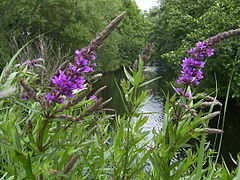Lythrum
| Lythrum | |
|---|---|

| |
| Lythrum salicaria | |
| Scientific classification | |
| Kingdom: | |
| Division: | |
| Class: | |
| Order: | |
| Family: | |
| Genus: | Lythrum |
| Species | |
|
See text. | |
| Synonyms | |
Lythrum is a genus commonly known as loosestrife. It is one of 32 genera of the family Lythraceae.
Selected species
|
|
Formerly placed here
- Cuphea carthagenensis (Jacq.) J.F.Macbr. (as L. carthagenense Jacq.)
- Cuphea melanium (L.) R.Br. ex Steud. (as L. melanium L.)
- Cuphea parsonsia (L.) R.Br. ex Steud. (as L. parsonsia L.)
- Cuphea racemosa subsp. racemosa (as L. racemosum L.f.)
- Cuphea viscosissima Jacq. (as L. petiolatum L.)
- Pleurophora anomala (A. St.-Hil.) Koehne (as L. anomalum A.St.-Hil.)
- Woodfordia fruticosa (L.) Kurz (as L. fruticosum L.)[6]
Morphology
Some species of Lythrum are heterostylous, such as the tristylous (occurring in three forms) L. salicaria.[7]
Ecology
Lythrum species are used as food plants by the larvae of some Lepidoptera species including Emperor Moth, The Engrailed (recorded on Lythrum salicaria), Hebrew Character and The V-pug.
References
Wikimedia Commons has media related to Lythrum.
Wikispecies has information related to Lythrum.
- ^ a b c Lythrum In: Species Plantarum 1: 446 (1753). No type given. "Lythrum". APNI, IBIS database. Canberra: Centre for Plant Biodiversity Research, Australian Government. Retrieved February 26, 2010.
- ^ "Genus: Lythrum L." Germplasm Resources Information Network. United States Department of Agriculture. 1998-04-28. Retrieved 2011-02-19.
- ^ "PLANTS profile for Lythrum L." PLANTS National Database Reports and Topics. USDA. Retrieved February 26, 2010.
- ^ Common name for L. junceum "Lythrum junceum (False Grass-poly)". Flora of Derbyshire. Derby City Council and Derbyshire Flora Committee. February 15, 2007. Retrieved February 26, 2010.
- ^ Common name for L. wilsonii "Innamincka Regional Reserve - Flora Species List (By Family)" (PDF). National Parks and Wildlife South Australia, Department for Environment and Heritage. Retrieved February 26, 2010.
- ^ "GRIN Species Records of Lythrum". Germplasm Resources Information Network. United States Department of Agriculture. Retrieved 2011-02-19.
- ^ Christopher G. Eckert, Domenica Manicacci and Spencer C. H. Barrett (1996). "Frequency-dependent selection on morph ratios in tristylous Lythrum salicaria (Lythraceae)". Heredity. 77 (6): 581–588. doi:10.1038/hdy.1996.185.
